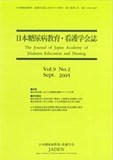Japanese
English
- 有料閲覧
- Abstract 文献概要
- 参考文献 Reference
- サイト内被引用 Cited by
本研究の目的は,受診を中断している糖尿病患者の受診行動に関連した療養生活体験を明らかにすることである.研究方法は,65歳以下の薬物療法を行っていない,受診を中断しやすい特徴をもつ患者で,受診中断が確認された16名に承諾を得て面接調査を実施し,質的に分析した.その結果,糖尿病患者の受診中断に関連した療養生活体験は,自己管理の自己効力感が高い型,受診再開の潜在型,現実逃避型,糖尿病に関連した受診の認識不足型の4タイプが明らかになった.療養生活体験は,全タイプに共通するカテゴリーと相違のあるカテゴリーがあった.共通するカテゴリーとして,受診時の〈受診による糖尿病の評価〉〈療養法を実践〉〈受診のために仕事を調整〉,受診中断の現在までに〈受診システムの非効率性〉〈指示的な医療者の対応〉〈糖尿病の軽症感〉の6つのカテゴリーであった.また,タイプによって異なる10のカテゴリーが抽出された.受診の継続を促す看護として,受診に関連した療養生活体験の相違を理解し,対象者に応じた援助の必要性が示唆された.
The present study was undertaken to clarify the daily living experiences of diabetic patients who dropped out of diabetes mellitus treatment programs. Sixteen diabetic patients of middle or high age (below 65 years), who were receiving no drug therapy, who had seemed to have characteristics potentially leading to dropout from treatment programs and who were confirmed to have actually dropped out, were enrolled in an interview-based survey under informed consent. The results of the survey were qualitatively analyzed. The patients were divided into four groups according to the type of daily life experiences associated with dropout from the treatment program: the high self-efficacy type (high awareness of the efficacy of self-management of the disease), the potentially compliant type (patients who have the potential of resuming clinic visits), the escape-from-reality type (patients who stop visiting clinics to escape from reality) and the inadequate recognition type (patients with inadequate recognition about mellitus treatment programs ). Daily life experiences were found to involve categories common to all 4 types and categories different among the 4 types. The six categories common for all 4 types were three categories pertaining to the beginning of treatment (“evaluation of diabetes by consultation”, “practice of the advised lifestyle”and “adjustment of job for clinic visits”), three categories pertaining to the dropping out phase (“inefficiency of the treatment system”and “instructions in a tone of command by care providers”and “underestimation of the significance of diabetes by the patient”). Ten categories different among the four types were also extracted. The results suggest that to encourage patients to continue clinic visits, nurses should understand inter-individual differences in daily life experiences related to treatment programs and provide support tailored to individual patients.
Copyright © 2005, Japan Academy of Diabetes Education and Nursing. All rights reserved.


